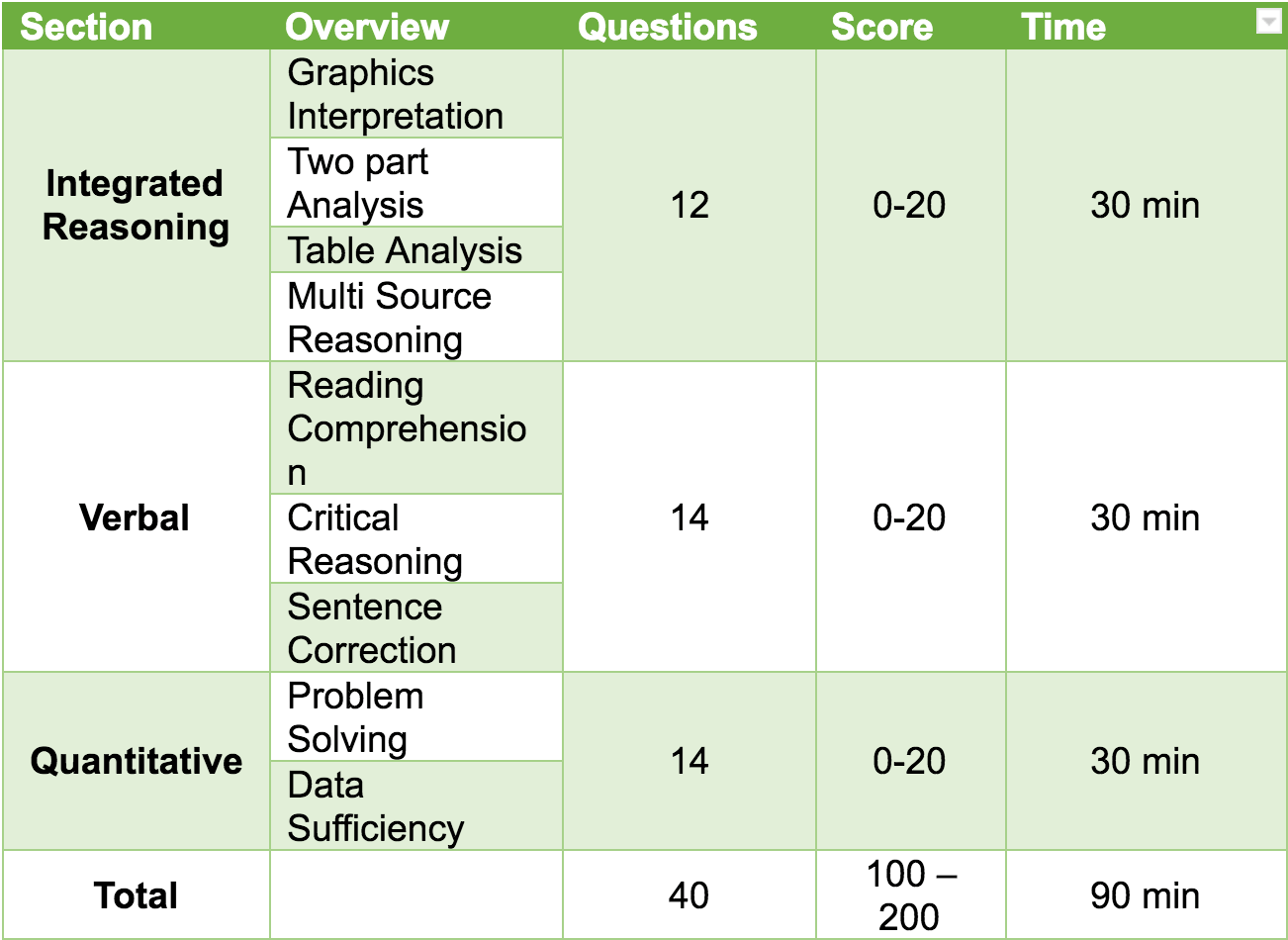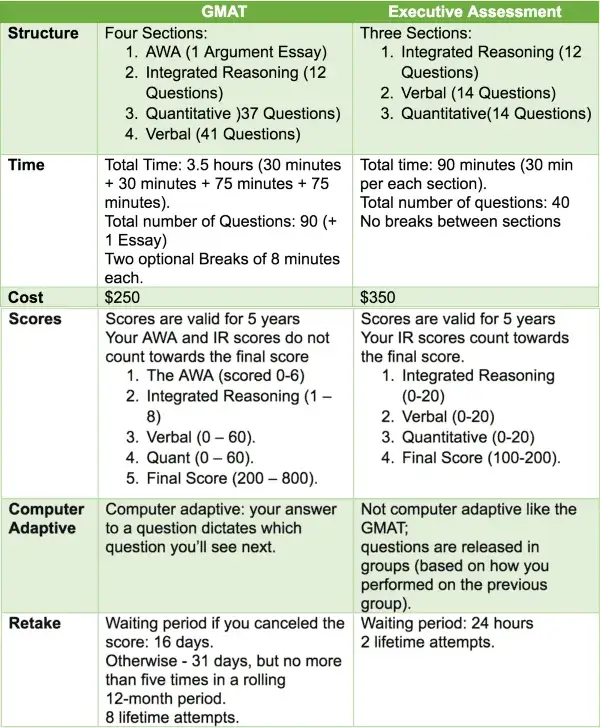So you have around 10 years of experience but do not have enough time to prepare for the GMAT. Fret not! GMAT has launched Executive Assessment for seasoned professionals like you in 2016. The Executive Assessment is a shorter version of the GMAT – a mini GMAT for working professionals. The test duration is 90 minutes and it tests you on the same sections as the GMAT does. However, the test does not have an AWA section. Let us take a look at how the exam is structured

Okay, cool. What else do you need to know?
- You do not have an essay/AWA section on the Executive Assessment.
- You do not have breaks between the sections. It is a 90-minute-long race from the beginning to the end.
- The Integrated Reasoning Section score counts towards your final score!
- The ordering of the sections is different – Integrated Reasoning, Verbal, and then Quantitative.
- You have to cough up more money to register for the exam than you would if you take the GMAT. The registration fee is $350 plus taxes.
- The test can be rescheduled for free and can be rescheduled any number of times.
- You cannot attempt the Executive Assessment more than twice.
- You can retake the exam within 24 hours.
- The test is not computer adaptive like the GMAT. Questions are released in groups based on how you perform on the previous group of questions.
Here is a table summarizing the differences between the GMAT and the Executive Assessment

Okay… So, which colleges accept the Executive Assessment?
Not many. So far 7 schools have signed up. Among them are Chicago Booth, Columbia Business School, Darden, LBS, INSEAD, Hong Kong Business School and CEIBS.
The program is currently in the beta-testing phase and you can expect many more schools to sign on to this in the coming months.
Note that CEIBS indicates a preference for Executive Assessment over other standardized tests.
Where is the test delivered?
You can check the testing locations in your city here – http://www.pearsonvue.com/gmacassessments/sa/
If you are from Bangalore, the test can be scheduled either at Koramangala or at Dickenson Road Center.
Note that you need your Passport to take the test.
What about Rescheduling and Cancellations?
You can reschedule your test as many times as necessary up to 24 hours before the scheduled appointment. This can be done free of cost. However, reschedules are not allowed less than 24 hours before your scheduled assessment. If you need to reschedule less than 24 hours before your scheduled assessment, you will forfeit your assessment fee and will need to schedule and pay for a new assessment. You may cancel your assessment (without rescheduling) up to 24 hours prior to your scheduled appointment. You will be refunded USD $250 out of the $350 that you paid while registering for the test. Cancellations are not allowed less than 24 hours before your scheduled assessment. If you need to cancel less than 24 hours before your scheduled assessment, you will forfeit your assessment fee.
Note that you cannot cancel your results.
What about the Sections on the test? How different are they from the GMAT for Working Professionals?
Well, let us talk about each section
1. Integrated Reasoning
This section is very much the same as that on the GMAT. You need to answer 12 questions in 30 minutes. You may get any of these four question types.
Multi-Source Reasoning
Graphical Analysis
Table Analysis, and Two-part Analysis.
Integrated Reasoning is much more important on this exam than on the GMAT.
This section score actually goes into your final score. You are allowed to use the on-screen calculator in this section. You won’t be provided this facility on any other section.
2. Verbal Section
You need to answer 14 questions in 30 minutes. Hence, timing is more generous on the EA than on the GMAT. You get to spend around 128 seconds, on average, per question, compared to 109 seconds on the GMAT.
3. Sentence Correction
Sentence Correction topics seem to encompass the same range as the questions from GMAT. You can probably ignore the Advanced topics section of our course.
4. Critical Reasoning
Critical Reasoning is also consistent with official GMAT questions. You should focus more on the standard types of questions such as Find the Assumption, Strengthen, Weaken, and Inference.
5. Reading Comprehension
Reading Comprehension section differs somewhat from the GMAT. Some passages might come only with one question. (Typically, on the GMAT, you expect to see 3-4 questions per passage). Some passages (around 130 words) are noticeably shorter than the typical GMAT passage.
6. Quantitative Section
You need to answer 14 questions in 30 minutes. The time allocated per question here is pretty much the same as on the GMAT. You will get pretty much the same type of questions – on Problem Solving and Data Sufficiency.
What else do I need to know about the sections?
The Executive Assessment comprises five modules
- Integrated Reasoning – 12 questions
- Verbal Reasoning 1 – 7 questions
- Verbal Reasoning 2 – 7 questions
- Quantitative Reasoning 1 – 7 questions
- Quantitative Reasoning 2 – 7 questions.
At the end of each of the five modules, you will be presented with a review screen that will provide an opportunity for you to review and change your responses or return to any questions you may have skipped.
Note that you can only review and change responses within a given module. Once you have moved onto the next module, the question responses on the previous module can’t be changed.
What about Program Selections as GMAT ?
When you create an account to register for the exam, you will be asked to select the program(s) that should receive your assessment results. You may select as many programs as you’d like, and you may change the program selections prior to taking the assessment. Once you have taken the assessment, only new schools can be selected to receive your results. If you retake/register for a second assessment, you may change your school selections.
How should you study?
GMAT suggests that you can take the EA with a minimal amount of preparation. Preparation for this test should take you around a month. Focus more on the fundamentals and standard types of questions. All the Best! I hope this article helped you in understanding – how the Executive Assessment is different from the GMAT. If you loved the blog, please let us know in the comments!
Pro Tip: Curious about how to start off your own journey towards an awe-inspiring GMAT score? Try out our free GMAT Online Trial course.

